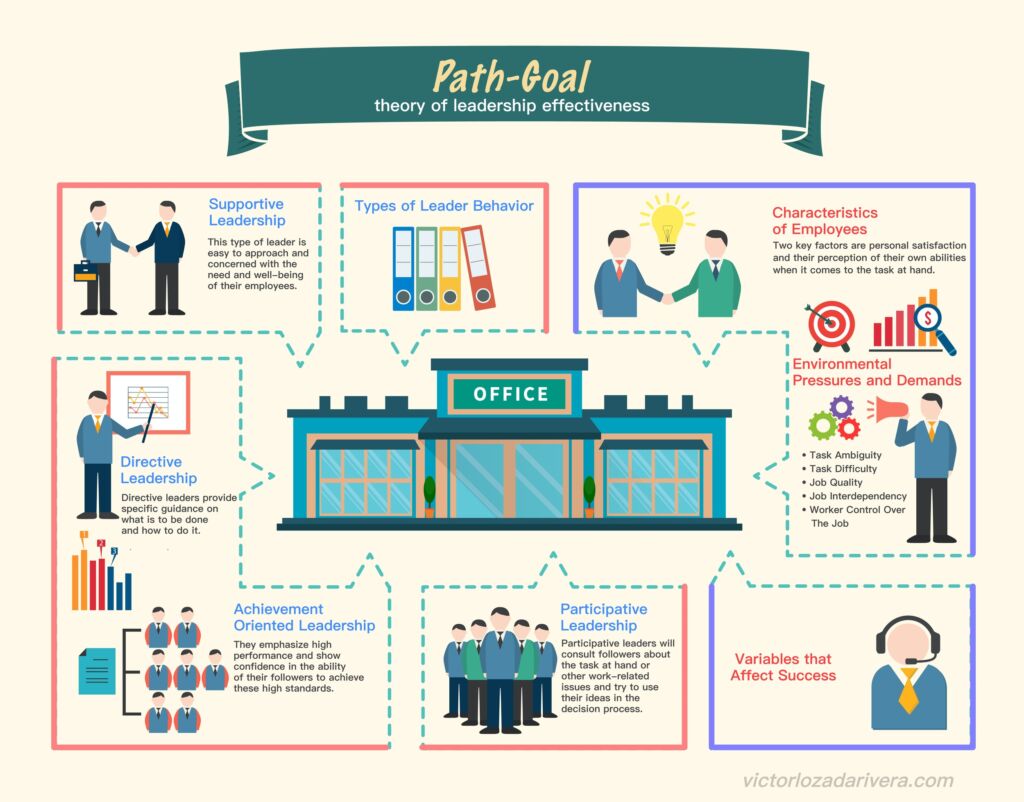Path-goal theory is a theory of leadership that shows the impact of a leader’s behavior on employee motivation, satisfaction, effort, and performance.
The theory was developed in the 1970s by Martin Evans and Robert House. The theory suggests that for a leader to do well, one must be able to identify to the employees how to achieve certain goals. The theory focuses on individuals’ personal goals, perceptions of the goals of the organization as a whole, and effective paths toward achieving those goals.

Overview
Path-goal theory is about how leaders motivate their employees or followers to achieve certain goals. The theory identifies four main types of leader behavior and two types of variables that affect success:
Types of Leader Behavior:
- Directive Leadership
- Supportive Leadership
- Participative Leadership
- Achievement-Oriented Leadership
Variables that Affect Success:
- Personal Characteristics of Employees
- Environmental Pressures and Demands
Let’s look in depth at all 6 elements:
Directive Leadership
In the Directive approach, leaders provide specific guidance on what is to be done and how to do it. They set performance standards and ensure that their employees follow set rules, guidelines, and schedules.
Supportive Leadership
This type of leader is easy to approach and concerned with the need and well-being of their employees. Supportive leaders treat their followers as equals and will ensure the working environment is as stress-free as possible.
Participative Leadership
Participative do as the word says, they encourage participation from their employees. Participative leaders will consult followers about the task at hand or other work-related issues and try to use their ideas in the decision-making process.
Achievement-Oriented Leadership
Leaders that are achievement-oriented work to set challenges and goals for their employees. They emphasize high performance and show confidence in the ability of their followers to achieve these high standards.
Deciding on what leadership style to adopt is contingent upon many situational factors. These include workers’ personality and their specific locus of control. Locus of control is a psychological term that refers to whether a person assumes responsibility for their wrongdoings.
According to path-goal theory, leaders should be able to adapt and choose the correct leadership style according to the situation.
Variables That Affect Success
Path-goal leadership theory identifies two main variables:
- Personal Characteristics of Employees
- Environmental Pressures and Demands
Personal Characteristics of Employees
As it pertains to employees, two key factors to consider are their personal satisfaction and their perception of their own abilities when it comes to the task at hand.
- Do the employees like their jobs?
- Have tasks been explained in ways that allow employees to feel confident in their abilities to complete them?
- Do the employees see their leader’s behavior as a source of immediate or future satisfaction?
- Do they have the appropriate level of training to complete the job?
These are all factors that leaders must take into account when determining how to motivate their followers to achieve a desired goal.
Environmental Pressures and Demands
The path-goal theory of leadership identifies five variables when looking at environmental pressures and demands:
- Task Ambiguity
- Task Difficulty
- Job Quality
- Job Interdependency
- Worker Control Over The Job
Task Ambiguity
If the task at hand is not clear, employees may struggle to complete it correctly. The same holds true for task difficulty.
Task Difficulty
If a job is above employees’ skill level, they may not be able to complete it and grow frustrated. A leader in the path-goal model would clearly identify the directions and ensure that employees are able to complete the task for the goal to be reached.
Job quality
Path-goal theory suggests that lower-quality jobs need more leadership because employees in these positions need more motivation to achieve set goals.
Interdependency
If a job requires more a large number of people working together, it will require more leadership. Jobs in which many people work together to reach a goal will need a high level of coordination from the leader to ensure that work is not repeated or missed.
Worker Control Over The Job
If employees can take more control or ownership in the job and work on their own, less leadership is needed.
Example of Path Goal theory at Columbia Records
At the end of the nineteenth century, Columbia executives encountered a problem related to the fact that companies were selling unreliable equipment and were resistant to collaborating with Columbia for creating better sound recording devices.
An innovative work practice by Columbia founder Edward Easton was to consider his employees as team members and invaluable knowledge producers and allow them time for thinking. By 1890, Columbia music engineers already came up with the invention of prerecorded musical cylinders: They would first sell them to exhibitors and coin-slot operators.
Columbia’s participative leadership style allowed hundreds of workers to contribute to inventions in the music industry.
In 1948, Columbia Records introduced the LP record format. The introduction of the LP record format was in part due to Dr. Peter Goldmark’s collaborative mindset. Goldmark was an engineering supervisor at Columbia Records.
His managerial style encouraged participation from various employees. He was said to be humble, down-to-earth, and considerate of his employees’ opinions and insights.
Conclusion
Ultimately, path-goal theory suggests that leaders can change their style, or behavior, to meet the demands of particular situations. Leaders can motivate employees to achieve the goals of the organization, resulting in their own personal satisfaction.
Sources:
Vandegrift, Rebecca, and Jonathan Matusitz. “Path-Goal Theory: A Successful Columbia Records Story.” Journal of Human Behavior in the Social Environment, vol. 21, no. 4, May 2011, pp. 350–362.
Chance, Patti L. Introduction to Educational Leadership & Organizational Behavior: Theory into Practice. Eye on Education, 2009.


